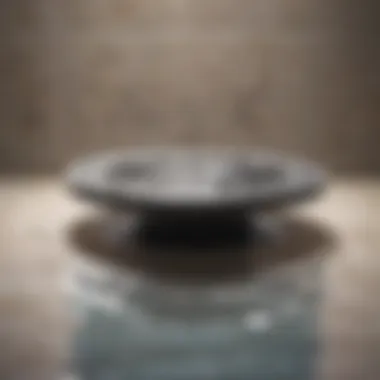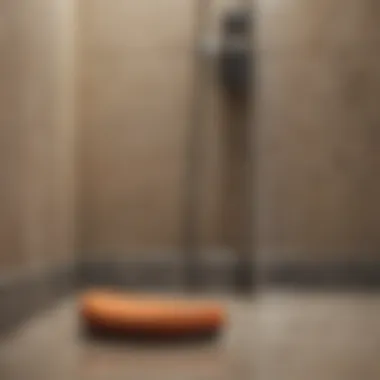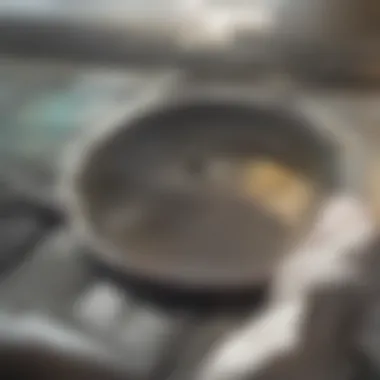Effective Solutions for Clogged Shower Drains


Intro
Dealing with a clogged shower drain can be frustrating and inconvenient. This common household issue often arises from various factors such as hair, soap residue, and other debris accumulating over time. Understanding the causes of clogs, as well as the tools and methods to resolve them, is crucial for homeowners. In this article, we will delve deeply into effective techniques for unclogging shower drains and preventive measures that can help maintain clear water flow.
By knowing when to attempt a DIY solution and when to call a professional, you can save both time and money while ensuring the smooth functioning of your plumbing system.
Understanding Clogged Shower Drains
Clogged shower drains are a common issue that many homeowners face. Understanding the underlying mechanisms of these drains, the causes behind frequent clogs, and how specific materials contribute to drainage problems is essential. This knowledge not only aids in effective solutions but also in prevention strategies that can save time and money. Through this section, readers will grasp the importance of maintaining clear shower drains to ensure longer-lasting plumbing systems.
The Mechanism of Shower Drains
Shower drains are designed to direct water flow away efficiently. Generally, they consist of several parts: the drain cover, the strainer, and the pipes leading to the waste system. The drain cover prevents large debris from entering the system while the strainer allows water to escape. When functioning correctly, water flows freely down the pipes. However, when the flow is impeded, it often signals a clog that needs attention.
Common Causes of Clogs
Recognizing the common causes of clogged shower drains is a pivotal step in effective maintenance. The most frequent culprits include:
- Hair, which can easily bunch up and trap other materials.
- Soap and shampoo residue, which can solidify into a sticky substance that hampers water flow.
- Mineral deposits from hard water, leading to buildup over time.
- Foreign objects, which are sometimes accidentally dropped into the drain.
Understanding these causes helps the homeowner identify the issue quickly and address it.
The Role of Hair and Soap Residue
Hair is the predominant factor in most shower drain clogs. It does not dissolve in water and can easily tangle with soap residue. This combination can create a dense blockage that resists typical solutions. Moreover, soaps that contain oils or moisturizers can also lead to sticky residue on the pipe walls, enhancing the chances of hair and debris sticking to them. Regular cleaning and the use of hair catchers can significantly mitigate these problems.
Initial Assessment of the Clog
In tackling a clogged shower drain, the initial assessment holds significant importance. This step allows homeowners to gain insight into the specific nature and extent of the clog. A proper assessment can save time, prevent unnecessary expenses, and guide the choice of the appropriate unclogging method. If one skips this step, they risk using wrong tools or techniques, leading to more complications.
Understanding and identifying specific signs of a clogged drain can often lead to a quick resolution. Moreover, assessing the clog’s severity enables one to determine whether it requires basic home remedies or professional intervention.
Identifying Signs of a Clogged Drain
Recognizing the signs of a clogged drain is a critical first step. Homeowners often experience delayed drainage or pooling water in the shower. There may also be unusual sounds, like gurgling, when water drains. These manifestations are primary indicators to be aware of.
Other signs include:
- Foul smells emerging from the drain
- Increased frequency in drain blockages
- Water backing up into other fixtures, like the toilet or sink
It is essential to remain attentive to these signals. Early detection may lead to straightforward resolutions before the clog escalates further, resulting in potential damage to plumbing.
Determining the Severity of the Clog
Once signs of a clog are evident, the next step is to evaluate the severity of the issue. Not all clogs are created equal; they can range from minor blockages to complete obstructions. Minor clogs typically slow down drainage but do not present immediate risks. In contrast, severe clogs can lead to flooding or sewage backup, posing greater dangers.


Consider these factors when determining severity:
- Duration: How long has the clog persisted?
- Water Level: Is water pooling significantly or just mildly?
- Previous Attempts: Have any unclogging attempts been made? Effective or ineffective?
This assessment is not just about convenience; it’s about preventing potential hazards. Understanding the severity guides how urgent the response must be—whether to use a plunger, a drain snake, or to consult a plumbing professional.
Proper assessment is the foundation of effective drain maintenance. Neglecting it can amplify problems that may have been easily fixed.
Essential Tools for Unclogging
Unclogging a shower drain requires the right tools to make the task efficient and effective. Understanding the essential tools can significantly ease the process. Each tool has a specific purpose and knowing how to use them can save time and effort. Magic is often thought to lie in the hands of professionals, but with proper tools and techniques, homeowners can tackle clogs with confidence.
Plungers and Their Variants
Plungers are commonly regarded as the go-to tool for unclogging drains, and for a good reason. Their simplicity and effectiveness in creating pressure make them an invaluable asset in your toolkit. There are different types of plungers:
- Cup Plunger: The most recognized variant, often used in kitchens and bathrooms. Its rubber cup is designed to create a vacuum seal, creating sufficient pressure to dislodge clogs.
- Flange Plunger: Similar in shape to the cup plunger but with an extended flange. This design is specifically made for toilets but can also be used for shower drains in some situations.
To use a plunger effectively, place it over the drain and ensure a proper seal. Push down gently at first, then forcefully pull up. Repeat this motion several times to generate ample pressure. Careful application is key; too much force can risk damaging the plumbing.
Drain Snakes and Augers
When a plunger fails to dislodge a stubborn clog, a drain snake or auger might be the solution. These tools are excellent for reaching deeper clogs that are out of reach. A drain snake is a flexible cable with a spiral tip that breaks apart clogs when inserted into the drain.
- Handheld Drain Snake: Suitable for smaller clogs, this variant can be operated manually, allowing the user to control the depth and pressure applied to the clog.
- Motorized Drain Auger: A more advanced option, this type is used for more significant clogs and requires electricity to function.
To use a drain snake, insert it into the drain, slowly turning the handle to maneuver through pipes. When resistance is felt, it signals the presence of a clog. Continue moving the snake until the obstruction is cleared or broken apart.
Chemical Drain Cleaners: Pros and Cons
Chemical drain cleaners are often considered a quick solution for a clogged shower drain. They work by using powerful chemicals to dissolve clogs. However, they do come with their own set of considerations.
Pros:
- Ease of Use: Simply pour the cleaner down the drain and let it sit.
- Immediate Results: For simple clogs, chemical cleaners often provide an instant fix.
Cons:
- Potential Damage: Harsh chemicals can corrode pipes over time, especially if used excessively.
- Health Risks: Proper precautions must be taken when handling these substances to avoid accidents or injuries.
Using chemical cleaners should always be a last resort or complement to other methods. It is essential to follow the manufacturer’s guidelines strictly and never mix different types of chemicals.
By understanding the importance of these tools and their proper application, homeowners can effectively manage clogged shower drains. Each method offers specific advantages, and knowing when to use each is crucial for maintaining efficient plumbing.
Step-by-Step Unclogging Process


Addressing a clogged shower drain effectively requires a structured approach. The Step-by-Step Unclogging Process provides a clear roadmap to restore proper drainage. Each step not only tackles the immediate issue but also sets the foundation for future maintenance. This section is essential as it equips homeowners with practical knowledge to resolve common drain clogs efficiently, minimizing frustration and potential costs related to professional plumbing services.
Preparation and Safety Measures
Before attempting to unclog a shower drain, preparing adequately is crucial. Start by assembling the tools needed for the task. Common items include a plunger, a drain snake, and, optionally, chemical cleaners.
Additionally, ensure that the working area is safe and clean. Wear gloves to protect your hands from germs and potential irritants. If using chemical cleaners, ensure the bathroom is well-ventilated to avoid inhalation of fumes. Having towels or a bucket handy to catch any overflow will also make the process smoother.
Taking these preparation and safety steps can prevent unnecessary accidents and improve the efficiency of the unclogging process.
Using a Plunger Effectively
Using a plunger can seem simple, yet executing it properly is key to its effectiveness. Start by filling the shower with enough water to cover the plunger’s rubber cup. This will create a better seal and increase suction.
Position the plunger over the drain. Ensure a tight fit so that air does not escape during plunging. Push down firmly without breaking the seal. Use strong up-and-down movements for about 30 seconds. After this, quickly remove the plunger to check if the water drains away. If not, repeat the process a few times. If successful, let the water run for a bit to ensure it flows freely. This technique can resolve minor clogs quickly.
Employing a Drain Snake
When plunging does not work, a drain snake may be necessary. A drain snake, or auger, can reach deeper and removes stubborn clogs more effectively. To start, insert the snake into the drain opening carefully. Turn the handle clockwise as you push it deeper.
As the snake encounters resistance, continue turning the handle. This action helps the snake to latch onto the clog. Once you feel that the clog is broken, slowly pull the snake out while turning it counterclockwise. Be prepared for debris that may come out with it. After removing the snake, flush the drain with hot water to clear out any remaining particles. This method is highly effective for hair and soap residue, which are common contributors to shower clogs.
Applying Chemical Cleaners: A Cautionary Approach
Chemical drain cleaners can be tempting for stubborn clogs. However, these products must be used with care due to their harsh ingredients. Always follow the manufacturer’s instructions on the label. Wearing gloves and eye protection is crucial during this process.
Pour the recommended amount into the drain. Let it sit for the specified time before flushing with hot water. While these cleaners can break down clogs, they can also damage pipes over time, especially in older plumbing systems. Consider this option as a last resort. If problems persist, consult a professional to avoid further complications.
Always consider the long-term health of your plumbing before using chemical solutions; prevention goes a long way.
By following this systematic process, homeowners can effectively address their plumbing challenges. Proper understanding and execution of each step will not only resolve current issues but also reduce the likelihood of clogs in the future.
Post-Unclogging Maintenance
Post-unclogging maintenance is crucial for ensuring the longevity and functionality of your shower drain. Once you have successfully cleared a clog, the objective shifts to preventing future issues. The work done to unclog a drain can feel rewarding, but neglecting ongoing maintenance can lead to a repeat of the frustrating experience.
The first element of maintenance is understanding the types of debris that commonly affect shower drains. Hair and soap residue are primary culprits. Regularly removing hair from the drain and surrounding area can significantly reduce the risk of clogs forming again. Additionally, soap buildup can accumulate and create a barrier that restricts water flow. Implementing simple yet effective cleaning routines can help maintain clear drainage and avoid the need for emergency interventions.
Furthermore, talking about preventive measures involves thinking about a holistic approach. Less usage of chemical drain cleaners, for instance, is beneficial. These products can cause harm to the plumbing system over time. Instead, consider opting for natural cleaning solutions, as they tend to be gentler and safer for pipes.
To summarize, consistency is key in drain maintenance. Regular care can save time and money in the long run, providing homeowners peace of mind and a hassle-free experience.
Routine Cleaning Practices


Engaging in routine cleaning practices is vital to ensure that your shower drain remains unclogged over time. A simple schedule can lead to great results. Here are a few recommended practices:
- Weekly Hair Removal: Spend a few minutes each week clearing loose hair from the opening of the drain. This can be done simply with your fingers or a small tool designed for this purpose.
- Monthly Deep Clean: Once a month, use a mixture of baking soda and vinegar to give your drain a thorough cleanse. Use half a cup of each, pour them down the drain, allow them to sit for about thirty minutes, and then flush with hot water. This helps break down soap scum and other residues.
- Inspect Regularly: Make it a habit to check the drain if it looks slow. Catching an early sign of clogging can prevent larger issues later.
Integrating these practices into your routine helps maintain optimal water flow and minimizes the chances of encountering a clog again.
Using Drain Guards
Preventative tools like drain guards can significantly assist in maintaining your shower drain. Drain guards are mesh screens or small devices placed over the drain to catch hair, soap shards, and other debris before they enter the plumbing system. Using drain guards has several benefits:
- Effective Barrier: They act as a barrier to catch hair and larger particles which may cause clogs.
- Easy to Clean: Most drain guards are removable and easy to clean. Simply take it off and rinse it out when it becomes full.
- Cost-Effective: Investing in a drain guard is inexpensive compared to the cost of frequent plumbing services.
Consider placing a drain guard in your shower as an integral part of your maintenance routine. This small adjustment can greatly reduce the risk of clogs and enhance the overall functionality of your drainage system.
When to Consult Professionals
Addressing a clogged shower drain can often be a straightforward task that homeowners can tackle. However, certain situations may warrant the expertise of professional plumbers. Understanding when to seek professional assistance is vital for avoiding further complications and possibly expensive repairs. Here, we delve into key considerations for deciding when it's best to call in the experts.
Identifying Complicated Clogs
Some clogs, while noticeable, may not respond well to common unclogging methods. If water drains slowly or not at all, it could point to deeper issues in the plumbing system. Signs that you may be dealing with a complicated clog include:
- Persistent slow drainage after multiple attempts to unclog
- Frequent backups in other sinks or fixtures
- Foul odors coming from the drain
- Gurgling sounds during drainage, which could indicate trapped air
If you observe these signs, it may be a signal that the blockage is further along in the plumbing pipeline or caused by a non-traditional obstruction. At this point, it’s prudent to consult a professional who can diagnose the problem accurately and employ appropriate methods for resolution.
Understanding the Role of Professional Plumbers
Professional plumbers bring extensive training and tools that help diagnose and resolve plumbing issues effectively. They can identify not only the immediate cause of a drain issue but also underlying factors that may contribute to future problems. The benefits of hiring a professional include:
- Expert Analysis: Professionals can assess the plumbing system's overall health, something that can escape the average homeowner’s notice.
- Advanced Equipment: They utilize specialized tools, such as video inspection cameras, to locate the exact source of the clog without invasive measures.
- Preventing Damage: They can resolve issues that might lead to more significant damage, which could incur higher repair costs later.
- Long-Term Solutions: Professional intervention may lead to advice on better maintenance practices and preventive solutions, ensuring drains remain functional for longer.
Ultimately, the decision to engage a professional should weigh the complexity of the issue and the potential risks of DIY attempts. The goal is to ensure your home's plumbing remains efficient without unnecessary stress.
The Importance of Preventive Measures
When dealing with clogged shower drains, understanding preventive measures is crucial. This knowledge does not just save time and money; it also enhances the longevity of your plumbing system. Preventive actions contribute to a smoother daily routine and minimize the frustrations associated with sudden plumbing issues.
Understanding Drain Maintenance
Regular maintenance of your shower drain is essential. Simple practices, such as periodically removing hair and debris from the drain, can significantly reduce the likelihood of a clog. Establishing a routine cleaning schedule is beneficial.
- Use drain screens: Installing a well-fitted drain screen can trap hair and larger debris, preventing them from entering the plumbing system.
- Regular cleaning: Use a combination of hot water and vinegar to cleanse the drain at least once a month. This naturally breaks down soap residue and other build-up.
- Avoid harsh chemicals: Some chemical cleaners may cause damage to pipes over time, leading to more significant issues later.
These actions, while simple, can lead to better performance of your shower drainage system, thus avoiding a larger issue down the road.
Impact of Regular Inspections
Conducting regular inspections of your shower drain can catch potential problems early. This proactive approach can save expensive repairs and additional discomfort.
- Check for slow drainage: If water seems to pool for longer than usual, inspect for debris.
- Look for unusual noises: Gurgling or bubbling sounds can indicate air trapped in the plumbing, often a sign of impending clogs.
- Inspect plumbing fittings: Ensure all fittings and joints are tight and leak-free, to prevent small leaks from escalating.
By keeping an eye on these signs, you can address issues before they turn into significant plumbing disasters. Regular inspections are not simply a good practice; they become a vital component of preventive maintenance.
"An ounce of prevention is worth a pound of cure."
This adage especially holds true for plumbing. Prioritizing preventive measures now can save you from substantial inconveniences and costs in the future.







